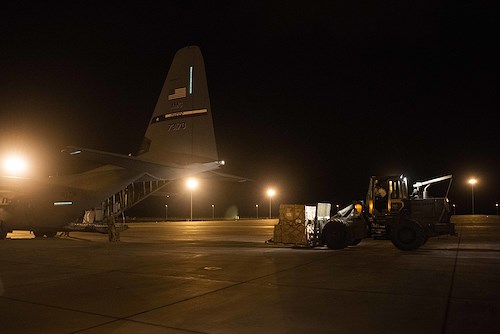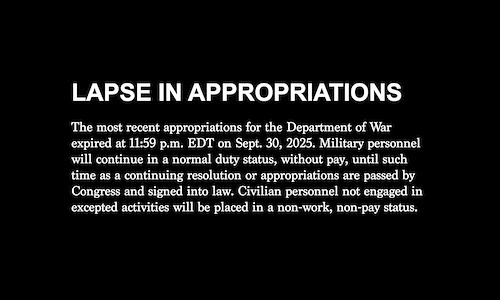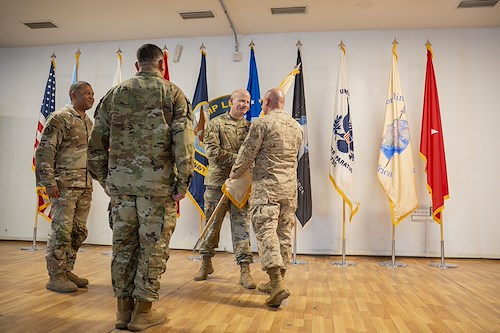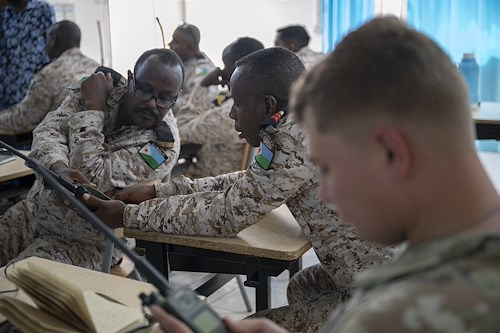Gallery contains 13 images
×
Photo 1 of 13
Combined Joint Task Force - Horn
U.S. Air Force Airmen assigned to the 75th Expeditionary Airlift Squadron (EAS), load a C-130J Super Hercules with cargo in Djibouti, Apr. 27, 2020. The 75th EAS provides strategic airlift capabilities across the Combined Joint Task Force-Horn of Africa (CJTF-HOA) area of responsibility and is responsible for moving many of the medical supplies pushed to outstations as part of the COVID-19 pandemic response. (U.S. Air Force photo by Tech. Sgt. Ashley Nicole Taylor)
Photo by: Tech. Sgt. Ashley Taylor
Photo 2 of 13
Combined Joint Task Force - Horn
U.S. Air Force Airmen assigned to the 75th Expeditionary Airlift Squadron (EAS), load a C-130J Super Hercules with cargo in Djibouti, Apr. 27, 2020. The 75th EAS provides strategic airlift capabilities across the Combined Joint Task Force-Horn of Africa (CJTF-HOA) area of responsibility and is responsible for moving many of the medical supplies pushed to outstations as part of the COVID-19 pandemic response. (U.S. Air Force photo by Tech. Sgt. Ashley Nicole Taylor)
Photo by: Tech. Sgt. Ashley Taylor
Photo 3 of 13
Combined Joint Task Force - Horn
U.S. Air Force Airmen assigned to the 75th Expeditionary Airlift Squadron (EAS), load a C-130J Super Hercules with cargo in Djibouti, Apr. 27, 2020. The 75th EAS provides strategic airlift capabilities across the Combined Joint Task Force-Horn of Africa (CJTF-HOA) area of responsibility and is responsible for moving many of the medical supplies pushed to outstations as part of the COVID-19 pandemic response. (U.S. Air Force photo by Tech. Sgt. Ashley Nicole Taylor)
Photo by: Tech. Sgt. Ashley Taylor
Photo 4 of 13
Combined Joint Task Force - Horn
A C-130J Super Hercules transports cargo loaded by U.S. Air Force Airmen assigned to the 75th Expeditionary Airlift Squadron (EAS), in Djibouti, Apr. 27, 2020. The 75th EAS provides strategic airlift capabilities across the Combined Joint Task Force-Horn of Africa area of responsibility and is responsible for moving many of the medical supplies pushed to outstations as part of the COVID-19 pandemic response. (U.S. Air Force photo by Tech. Sgt. Ashley Nicole Taylor)
Photo by: Tech. Sgt. Ashley Taylor
Photo 5 of 13
Combined Joint Task Force - Horn
A U.S. Air Force Airman assigned to the 75th Expeditionary Airlift Squadron (EAS), loads a C-130J Super Hercules with cargo in Djibouti, Apr. 27, 2020. The 75th EAS provides strategic airlift capabilities across the Combined Joint Task Force-Horn of Africa (CJTF-HOA) area of responsibility and is responsible for moving many of the medical supplies pushed to outstations as part of the COVID-19 pandemic response. (U.S. Air Force photo by Tech. Sgt. Ashley Nicole Taylor)
Photo by: Tech. Sgt. Ashley Taylor
Photo 6 of 13
Combined Joint Task Force - Horn
U.S. Army Sgt. Enock Langat, medical logistics noncommissioned officer for Combined Joint Task Force-Horn of Africa (CJTF-HOA), stands in front of medical supplies at Camp Lemonnier, Djibouti, Apr. 24, 2020. Since the inception of the COVID-19 outbreak, the MEDLOG team has shipped more than 7,000 surgical masks (facemasks), including 5,000 N95 respirators; 2,500 surgical gowns; 150 pairs of reusable goggles; and 20,000 pairs of gloves to outstations throughout East Africa. (U.S. Air Force photo by Tech. Sgt. Ashley Nicole Taylor)
Photo by: Tech. Sgt. Ashley Taylor
Photo 7 of 13
Combined Joint Task Force - Horn
U.S. Army Sgt. Enock Langat, medical logistics (MEDLOG) noncommissioned officer for Combined Joint Task Force-Horn of Africa (CJTF-HOA), prepares a shipment of medical supplies at Camp Lemonnier, Djibouti, Apr. 24, 2020. Since the inception of the COVID-19 outbreak, the MEDLOG team has shipped more than 7,000 surgical masks (facemasks), including 5,000 N95 respirators; 2,500 surgical gowns; 150 pairs of reusable goggles; and 20,000 pairs of gloves to outstations throughout East Africa. (U.S. Air Force photo by Tech. Sgt. Ashley Nicole Taylor)
Photo by: Tech. Sgt. Ashley Taylor
Photo 8 of 13
Combined Joint Task Force - Horn
A pallet of medical equipment awaits distribution from the Defense Logistics Agency (DLA) at Camp Lemonnier, Djibouti, Apr. 22, 2020. The medical equipment is part of Combined Joint Task Force-Horn of Africa’s (CJTF-HOA) protective measures for COVID-19 to maintain the health of the force. (U.S. Air Force photo by Tech. Sgt. Ashley Nicole Taylor)
Photo by: Tech. Sgt. Ashley Taylor
Photo 9 of 13
Combined Joint Task Force - Horn
U.S. Air Force Airmen assigned to the 75th Expeditionary Airlift Squadron (EAS), load a C-130J Super Hercules with cargo in Djibouti, Apr. 27, 2020. The 75th EAS provides strategic airlift capabilities across the Combined Joint Task Force-Horn of Africa (CJTF-HOA) area of responsibility and is responsible for moving many of the medical supplies pushed to outstations as part of the COVID-19 pandemic response. (U.S. Air Force photo by Tech. Sgt. Ashley Nicole Taylor)
Photo by: Tech. Sgt. Ashley Taylor
Photo 10 of 13
Combined Joint Task Force - Horn
U.S. Army Capt. Ethan Betts, medical logistics (MEDLOG) officer for Combined Joint Task Force-Horn of Africa (CJTF-HOA), places a medical sticker on a box of medical supplies at Camp Lemonnier, Djibouti, Apr. 24, 2020. CJTF-HOA’s MEDLOG is responsible for distributing supplies and healthcare equipment, whether it be a computer system, a bandage, narcotics or PPE, to medical providers anywhere in East Africa. (U.S. Air Force photo by Tech. Sgt. Ashley Nicole Taylor)
Photo by: Tech. Sgt. Ashley Taylor
Photo 11 of 13
Combined Joint Task Force - Horn
A pallet of medical equipment awaits distribution from the Defense Logistics Agency (DLA) at Camp Lemonnier, Djibouti, Apr. 22, 2020. The medical equipment is part of Combined Joint Task Force-Horn of Africa’s (CJTF-HOA) protective measures for COVID-19 to maintain the health of the force. (U.S. Air Force photo by Tech. Sgt. Ashley Nicole Taylor)
Photo by: Tech. Sgt. Ashley Taylor
Photo 12 of 13
Combined Joint Task Force - Horn
Brian Clark, a project supervisor for the Defense Logistics Agency (DLA), removes a cover from a pallet of medical equipment at Camp Lemonnier, Djibouti, Apr. 22, 2020. The medical equipment is part of Combined Joint Task Force-Horn of Africa’s (CJTF-HOA) protective measures for COVID-19 to maintain the health of the force. (U.S. Air Force photo by Tech. Sgt. Ashley Nicole Taylor)
Photo by: Tech. Sgt. Ashley Taylor
Photo 13 of 13
Combined Joint Task Force - Horn
U.S. Army Capt. Ethan Betts, medical logistics (MEDLOG) officer for Combined Joint Task Force-Horn of Africa (CJTF-HOA), prepares a shipment of medical supplies at Camp Lemonnier, Djibouti, Apr. 24, 2020. Since the inception of the global COVID-19 pandemic, the MEDLOG team has shipped more than 7,000 surgical masks (facemasks), including 5,000 N95 respirators; 2,500 surgical gowns; 150 pairs of reusable goggles; and 20,000 pairs of gloves to outstations throughout East Africa. (U.S. Air Force photo by Tech. Sgt. Ashley Nicole Taylor)
Photo by: Tech. Sgt. Ashley Taylor
The Combined Joint Task Force-Horn of Africa (CJTF-HOA) medical logistics (MEDLOG) team is distributing personal protective equipment (PPE) and other materials to multiple outstations in East Africa as part of the fight against COVID-19.
Since the inception of the global pandemic, the MEDLOG team has shipped more than 5,000 N95 respirators, 2,000 surgical masks, 2,500 surgical gowns, 150 pairs of reusable goggles, and 20,000 pairs of gloves from Camp Lemonnier to contingency locations in Somalia and Kenya. Each shipment contains a 30-day supply of materials used by down-range medical personnel to prevent the spread of the virus.
“Outstations require the ability to quarantine, isolate and treat a person suspected to have the COVID-19 virus,” said U.S. Army Capt. Ethan Betts, MEDLOG officer for CJTF-HOA. “So far, we have conducted two mass PPE shipments to all of our outstations specific to the outbreak, not including the supplies we were sending prior to the outbreak, such as hand sanitizer.”
According to Betts, MEDLOG is responsible for distributing anything that is used in healthcare, whether it be a computer system, a bandage, narcotics or PPE, to medical providers anywhere in the world. Betts said the MEDLOG team at Camp Lemonnier primarily works to distribute supplies to Task Force Guardian (TFG) medics in support of the various outstations in East Africa.
“MEDLOG is a very integral part of the CJTF-HOA mission, especially with current events, because force health protection is now being considered the same thing as force protection,” Betts said. “Keeping our service members healthy by implementing measures to reduce the spread of COVID-19 is a high-priority and necessary to effectively continue our mission.”
The success of each shipment relies on multiple agencies, ranging from the Defense Logistics Agency (DLA), which initially receives the cargo, to U.S. Transportation Command (TRANSCOM), which provides the aircraft that transports the supplies, and the airports at the receiving outstation’s country.
“The biggest obstacle we’ve faced is getting flights coordinated to deliver the PPE to the outstations. Due to COVID-19, some countries have more restrictions on air movement, which can interrupt our transfer process,” said U.S. Army Sgt. Enock Langat, MEDLOG noncommissioned officer for CJTF-HOA. “When there is a delay in the shipment, we have to find alternatives to get the equipment where it needs to go and in a timely manner.”
Without the supply shipments, the medical support teams at the various contingency locations would be impacted, which would have a negative effect on the overall missions, said U.S. Army Sgt. Makena Forestell, Task Force Guardian forward aid station noncommissioned officer in charge at a contingency location in Somalia.
“With the continued consideration and delivery of these critical supplies we are able to maintain our role as force multipliers,” he said. “We know, and are confident, that we can see all patients without the worry of contaminating other soldiers after exams. I would consider these supplies as my primary weapon in the fight against this pandemic.
“The communication and tireless effort and coordination to keep the austere and isolated locations, such as here in Somalia, adequately supplied with PPE is a testament to the dedication and passion of the Medical Logistics Offices in HOA.”
While MEDLOG has been able to keep CJTF-HOA’s outstations supplied with medical materials, they still have had to overcome shortage issues that have affected the Department of Defense (DoD) as a whole, particularly when it comes to items like N95 respirators.
“The N95 facemasks were widely used by many different professions, both military and civilian, but now there are a lot of people who wouldn’t normally use or need it that are trying to order it,” said Betts. “Historically, the demand for these items was relatively small because a carpenter may need one for an hour to do their job, but now we have millions of people trying to use this mask who didn’t before.”
To help decide the quantity and allocation of supplies such as the N95 facemasks, the DoD relies on the Joint Materiel Priorities and Allocation Board (JMPAB).
“Even though every service is ordering a surplus of medical items, those items are being reviewed first so that the JPMAB can verify the request is a legitimate need. Then it’s decided at the DoD and Joint Staff level who gets those supplies, and in what quantities,” Betts said. “Although it is an added barrier, it is a necessary one because it is meant to appropriately distribute materials and make sure each unit receives the supplies needed.”
Now that each outstation has received its initial 30-day supply of PPE, MEDLOG will continue to replenish the supply as needed and send other waves of medical equipment in the near future.
“Once we verify each outstation receives their PPE, we will switch our focus to sending out testing equipment, such as swabs and thermometers,” Betts said. “After we ensure each outstation has appropriate testing materials, we will then work on dispensing other materials needed to continue combatting COVID-19. This process will continue as long as necessary and as many times as necessary, until the risk of COVID-19 is suppressed.”











































